A New Fault Diagnosis Method for Unbalanced Data Based on 1DCNN and L2-SVM
Abstract
1. Introduction
- (1)
- Traditional fault diagnosis methods mostly use manual approaches for feature extraction and pattern recognition, which rely on tedious diagnoses of specific data by experts and technicians and cannot meet the needs of industrial monitoring of Big Data;
- (2)
- Most of the extracted features are shallow features, and the generalization performance may be constrained when facing complex classification problems.
- (1)
- Because the ReLU activation function in traditional CNN will assign all the negative values of 0, this may bring about a significant decrease in the recognition accuracy of the minority class samples. Therefore, here, the ReLU activation function is modified by Linear and SELU. Linear is utilized in the input layer to ensure that all input minority samples can enter the training model. SELU is used on the middle layer; it gives a small negative slope rather than 0 to the negative value for better application to minority class samples under data imbalance.
- (2)
- Aiming at the problem where the cross-entropy loss in traditional CNN treats all input samples equally when dealing with unbalanced data, the cross-entropy loss is replaced by the L2-SVM loss, and dynamic adjustment parameters are introduced to give a lower misclassification cost to the majority class samples and a higher misclassification cost to the minority class samples.
- (3)
- By adding a new modulation factor, the weight of more distinguishable samples is declined; thus, the model can focus on training samples that are hard to discern in the training process.
2. CNN and the Imbalanced Classification Problem
2.1. Introduction to CNN
- (1)
- Convolution layer. It is mainly a feature extractor for the input data, with the structure of multiple inner convolution kernels. Each element of the kernel is assigned a weight coefficient and a deviation value. Each neuron in this layer is attached to other neurons in the neighborhood of the previous layer, which means the size of the connected area relies upon the dimension of the convolution nucleus. Because of the one-dimensional original vibration data inputted in this paper, a one-dimensional convolution operation is adopted. If the input signal is , its length is , and the weight vector of the convolution kernel is , the expression of convolution and activation operations is:
- (2)
- Active layer. As in Equation (1), the convolution is a linear operation, and the result is a linear combination of various features. For better expression of the nonlinear relationship between features, some nonlinear factors are generally introduced through the activation function. At present, the most used activation function in CNN is ReLU; its mathematical definition is
- (3)
- Pooling layer. It is commonly inserted behind the convolutional layer, which can reduce the number of parameters and shorten the time of convolutional operations while effectively avoiding overfitting. The widely used pooling methods are maximum pooling and mean pooling. Since the performance of the former is better than the latter when dealing with one-dimensional time series, the maximum pooling method is used in this paper, and its calculation formula is
2.2. Problems of Traditional CNN in Dealing with Unbalanced Data
3. The Proposed Method
3.1. L2-SVM Loss with Dynamically Adjusted Parameters and Modulation Factors Is Constructed
3.2. Improvement of Activation Function for Unbalanced Classification Problem
3.3. Architecture and Parameters of the Proposed Method
- (1)
- Data preprocessing: the time-sequential signal is intercepted according to the sample length, and the samples of is constructed after preprocessing; is the number of samples.
- (2)
- Feature extraction and data dimensionality reduction: four alternating convolution and pooling layers are established layer by layer. Through multi-layer feature extraction, the more abstract and deeper signal features hidden in the data can be obtained. Through multi-layer pooling operation, the high-dimensional data can be transformed into low-dimensional data for subsequent data classification. Moreover, after the convolution layer, batch normalization is introduced to adjust the data distribution so as to accelerate the convergence process as well as improve the generalization ability of the model. The ReLU in traditional CNN is improved to Linear and SELU to avoid a large amount of data being suppressed before feature extraction, which will affect its recognition accuracy.
- (3)
- Fault classification: the cross-entropy loss is replaced by the L2-SVM loss, and two new parameters, namely, the dynamic adjustment parameter and the modulation factor, are introduced to increase the recognition accuracy of the minority class samples.
3.4. Fault Diagnosis Process
4. Experimental Verification
4.1. Case Study 1: Application in CWRU Datasets
4.1.1. Experimental Setup
4.1.2. Diagnostic Results and Analysis
4.1.3. Feature Learning Capability
4.1.4. Comparison Experiments
4.2. Case Study 2: Application to the Lab-Measured Bearing Datasets
4.2.1. Experimental Setup
4.2.2. Diagnostic Results and Analysis
4.2.3. Feature Learning Capability
5. Conclusions
Author Contributions
Funding
Institutional Review Board Statement
Informed Consent Statement
Data Availability Statement
Conflicts of Interest
References
- Wang, Q.; Zhao, B.; Ma, H.; Chang, J.; Mao, G. A method for rapidly evaluating reliability and predicting remaining useful life using two-dimensional convolutional neural network with signal conversion. J. Mech. Sci. Technol. 2019, 33, 2561–2571. [Google Scholar] [CrossRef]
- Rai, A.; Upadhyay, S.H. A review on signal processing techniques utilized in the fault diagnosis of rolling element bearings. Tribol. Int. 2016, 96, 289–306. [Google Scholar] [CrossRef]
- Widodo, A.; Yang, B.-S. Support vector machine in machine condition monitoring and fault diagnosis. Mech. Syst. Signal Process. 2007, 21, 2560–2574. [Google Scholar] [CrossRef]
- Lei, Y.; Lin, J.; He, Z.; Zuo, M.J. A review on empirical mode decomposition in fault diagnosis of rotating machinery. Mech. Syst. Signal Process. 2013, 35, 108–126. [Google Scholar] [CrossRef]
- Feng, Z.; Liang, M.; Chu, F. Recent advances in time-frequency analysis methods for machinery fault diagnosis: A review with application examples. Mech. Syst. Signal Process. 2013, 38, 165–205. [Google Scholar] [CrossRef]
- Li, C.; de Oliveira, J.V.; Cerrada, M.; Cabrera, D.; Sánchez, R.V.; Zurita, G. A Systematic Review of Fuzzy Formalisms for Bearing Fault Diagnosis. IEEE Trans. Fuzzy Syst. 2019, 27, 1362–1382. [Google Scholar] [CrossRef]
- Xu, G.; Liu, M.; Jiang, Z.; Söffker, D.; Shen, W. Bearing Fault Diagnosis Method Based on Deep Convolutional Neural Network and Random Forest Ensemble Learning. Sensors 2019, 19, 1088. [Google Scholar] [CrossRef] [PubMed]
- Landauskas, M.; Cao, M.; Ragulskis, M. Permutation entropy-based 2D feature extraction for bearing fault diagnosis. Nonlinear Dyn. 2020, 102, 1717–1731. [Google Scholar]
- Hinton, G.E.; Salakhutdinov, R.R. Reducing the Dimensionality of Data with Neural Networks. Science 2006, 313, 504–507. [Google Scholar] [PubMed]
- LeCun, Y.; Bengio, Y.; Hinton, G. Deep learning. Nature 2015, 521, 436–444. [Google Scholar] [CrossRef] [PubMed]
- Mousavi, N.S.; Vaferi, B.; Romero-Martínez, A. Prediction of Surface Tension of Various Aqueous Amine Solutions Using the UNIFAC Model and Artificial Neural Networks. Ind. Eng. Chem. Res. 2021, 60, 10354–10364. [Google Scholar] [CrossRef]
- Zhou, Z.; Davoudi, E.; Vaferi, B. Monitoring the effect of surface functionalization on the CO2 capture by graphene oxide/methyl diethanolamine nanofluids. J. Environ. Chem. Eng. 2021, 9, 106202. [Google Scholar]
- Otter, D.W.; Medina, J.R.; Kalita, J.K. A Survey of the Usages of Deep Learning for Natural Language Processing. IEEE Trans. Neural Netw. Learn. Syst. 2021, 32, 604–624. [Google Scholar] [CrossRef] [PubMed]
- Kuang, F.; Zhou, X.; Liu, Z.; Huang, J.; Liu, X.; Qian, K.; Gryllias, K. Computer-vision-based research on friction vibration and coupling of frictional and torsional vibrations in water-lubricated bearing-shaft system. Tribol. Int. 2020, 150, 106336. [Google Scholar] [CrossRef]
- Jiao, L.; Zhao, J. A Survey on the New Generation of Deep Learning in Image Processing. IEEE Access 2019, 7, 172231–172263. [Google Scholar] [CrossRef]
- Roshani, M.; Sattari, M.A.; Muhammad Ali, P.J.; Roshani, G.H.; Nazemi, B.; Corniani, E.; Nazemi, E. Application of GMDH neural network technique to improve measuring precision of a simplified photon attenuation based two-phase flowmeter. Flow Meas. Instrum. 2020, 75, 101804. [Google Scholar] [CrossRef]
- Khalil, R.A.; Jones, E.; Babar, M.I.; Jan, T.; Zafar, M.H.; Alhussain, T. Speech Emotion Recognition Using Deep Learning Techniques: A Review. IEEE Access 2019, 7, 117327–117345. [Google Scholar] [CrossRef]
- Vaferi, B.; Eslamloueyan, R. Hydrocarbon reservoirs characterization by co-interpretation of pressure and flow rate data of the multi-rate well testing. J. Pet. Sci. Eng. 2015, 135, 59–72. [Google Scholar] [CrossRef]
- Aljemely, A.H.; Xuan, J.; Jawad, F.K.J.; Al-Azzawi, O.; Alhumaima, A.S. A novel unsupervised learning method for intelligent fault diagnosis of rolling element bearings based on deep functional auto-encoder. J. Mech. Sci. Technol. 2020, 34, 4367–4381. [Google Scholar] [CrossRef]
- Zhou, K.; Cao, G.; Zhang, K.; Liu, J. Domain adaptation-based deep feature learning method with a mixture of distance measures for bearing fault diagnosis. Meas. Sci. Technol. 2021, 32, 095105. [Google Scholar] [CrossRef]
- Pan, T.; Chen, J.; Qu, C.; Zhou, Z. A method for mechanical fault recognition with unseen classes via unsupervised convolutional adversarial auto-encoder. Meas. Sci. Technol. 2021, 32, 035113. [Google Scholar] [CrossRef]
- Nguyen, V.H.; Cheng, J.S.; Yu, Y.; Thai, V.T. An architecture of deep learning network based on ensemble empirical mode decomposition in precise identification of bearing vibration signal. J. Mech. Sci. Technol. 2019, 33, 41–50. [Google Scholar] [CrossRef]
- Shao, H.; Jiang, H.; Wang, F.; Zhao, H. An enhancement deep feature fusion method for rotating machinery fault diagnosis. Knowl. Based Syst. 2017, 119, 200–220. [Google Scholar] [CrossRef]
- Jing, L.; Zhao, M.; Li, P.; Xu, X. A convolutional neural network based feature learning and fault diagnosis method for the condition monitoring of gearbox. Measurement 2017, 111, 1–10. [Google Scholar] [CrossRef]
- Wen, L.; Li, X.; Gao, L.; Zhang, Y. A New Convolutional Neural Network-Based Data-Driven Fault Diagnosis Method. IEEE Trans. Ind. Electron. 2018, 65, 5990–5998. [Google Scholar] [CrossRef]
- Mukhopadhyay, R.; Panigrahy, P.S.; Misra, G.; Chattopadhyay, P. Quasi 1D CNN-based Fault Diagnosis of Induction Motor Drives. In Proceedings of the 2018 5th International Conference on Electric Power and Energy Conversion Systems (EPECS), Kitakyushu, Japan, 23–25 April 2018; IEEE: Piscataway, NJ, USA, 2018; pp. 1–5. [Google Scholar]
- Chen, R.; Huang, X.; Yang, L.; Xu, X.; Zhang, X.; Zhang, Y. Intelligent fault diagnosis method of planetary gearboxes based on convolution neural network and discrete wavelet transform. Comput. Ind. 2019, 106, 48–59. [Google Scholar] [CrossRef]
- Hoang, D.-T.; Kang, H.-J. Rolling element bearing fault diagnosis using convolutional neural network and vibration image. Cogn. Syst. Res. 2019, 53, 42–50. [Google Scholar] [CrossRef]
- Lessmeier, C.; Kimotho, J.; Zimmer, D.; Sextro, W. Condition Monitoring of Bearing Damage in Electromechanical Drive Systems by Using Motor Current Signals of Electric Motors: A Benchmark Data Set for Data-Driven Classification. In Proceedings of the European Conference of the PHM Society 2016, Bilbao, Spain, 5–8 July 2016. [Google Scholar]
- Ince, T.; Kiranyaz, S.; Eren, L.; Askar, M.; Gabbouj, M. Real-Time Motor Fault Detection by 1-D Convolutional Neural Networks. IEEE Trans. Ind. Electron. 2016, 63, 7067–7075. [Google Scholar] [CrossRef]
- Eren, L. Bearing Fault Detection by One-Dimensional Convolutional Neural Networks. Math. Probl. Eng. 2017, 2017, 8617315. [Google Scholar] [CrossRef]
- Huang, S.; Tang, J.; Dai, J.; Askar, M.; Gabbouj, M. Signal Status Recognition Based on 1DCNN and Its Feature Extraction Mechanism Analysis. Sensors 2019, 19, 2018. [Google Scholar] [CrossRef]
- Li, H.; Huang, J.; Ji, S. Bearing Fault Diagnosis with a Feature Fusion Method Based on an Ensemble Convolutional Neural Network and Deep Neural Network. Sensors 2019, 19, 2034. [Google Scholar] [CrossRef]
- Cao, J.; He, Z.; Wang, J.; Yu, P. An Antinoise Fault Diagnosis Method Based on Multiscale 1DCNN. Shock Vib. 2020, 2020, 8819313. [Google Scholar] [CrossRef]
- Liu, Z.; Wang, H.; Liu, J.; Qin, Y.; Peng, D. Multitask Learning Based on Lightweight 1DCNN for Fault Diagnosis of Wheelset Bearings. IEEE Trans. Instrum. Meas. 2021, 70, 1–11. [Google Scholar] [CrossRef]
- Huang, S.; Tang, J.; Dai, J.; Wang, Y. 1DCNN Fault Diagnosis Based on Cubic Spline Interpolation Pooling. Shock Vib. 2020, 2020, 1949863. [Google Scholar] [CrossRef]
- Jia, F.; Lei, Y.; Lu, N.; Xing, S. Deep normalized convolutional neural network for imbalanced fault classification of machinery and its understanding via visualization. Mech. Syst. Signal Process. 2018, 110, 349–367. [Google Scholar] [CrossRef]
- Tang, Y. Deep Learning using Linear Support Vector Machines. arXiv 2015, arXiv:1306.0239. [Google Scholar]
- Zhang, W.; Peng, G.; Li, C.; Chen, Y.; Zhang, Z. A New Deep Learning Model for Fault Diagnosis with Good Anti-Noise and Domain Adaptation Ability on Raw Vibration Signals. Sensors 2017, 17, 425. [Google Scholar] [CrossRef]
- CWRU. Case Western Reserve University Bearing Date Center Website; CWRU: Cleveland, OH, USA, 2006; Available online: https://engineering.case.edu/bearingdatacenter/download-data-file (accessed on 12 January 2020).
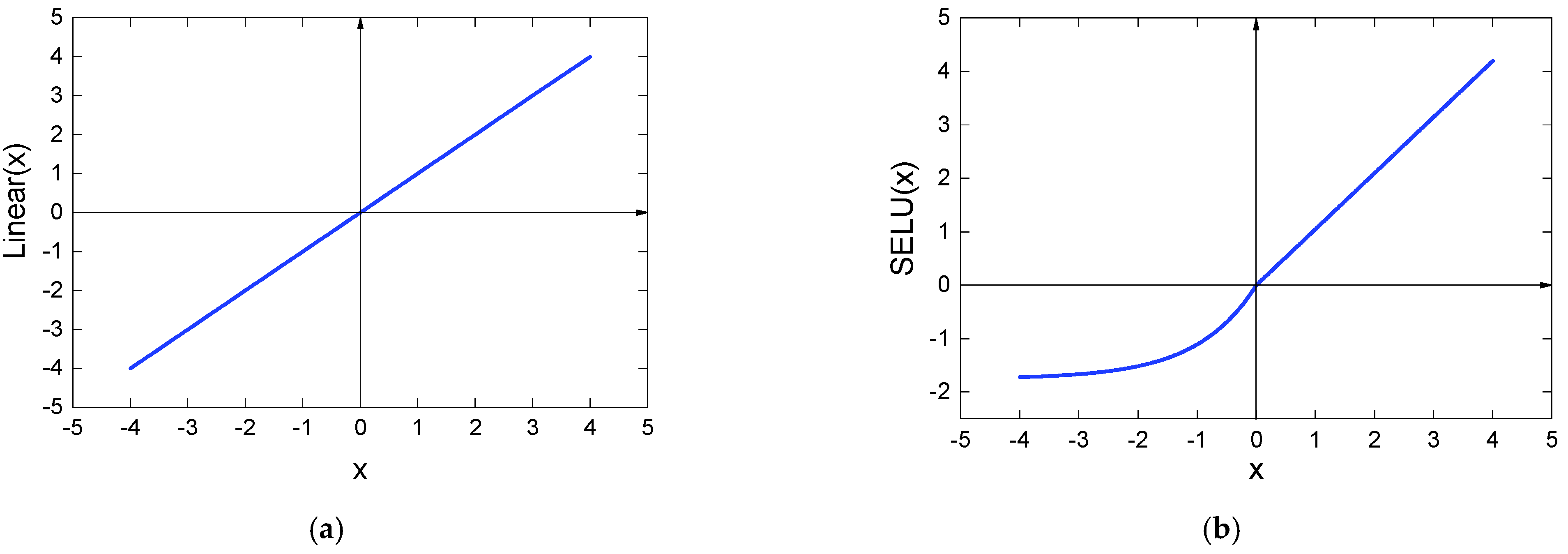
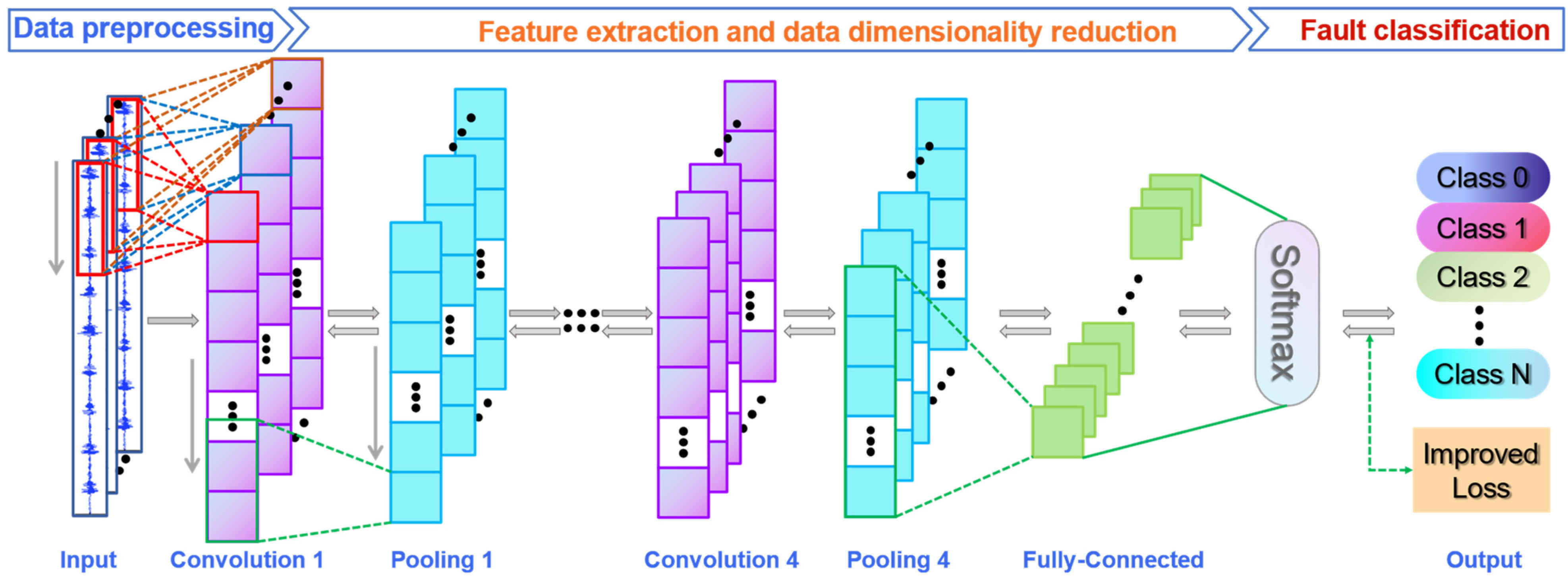
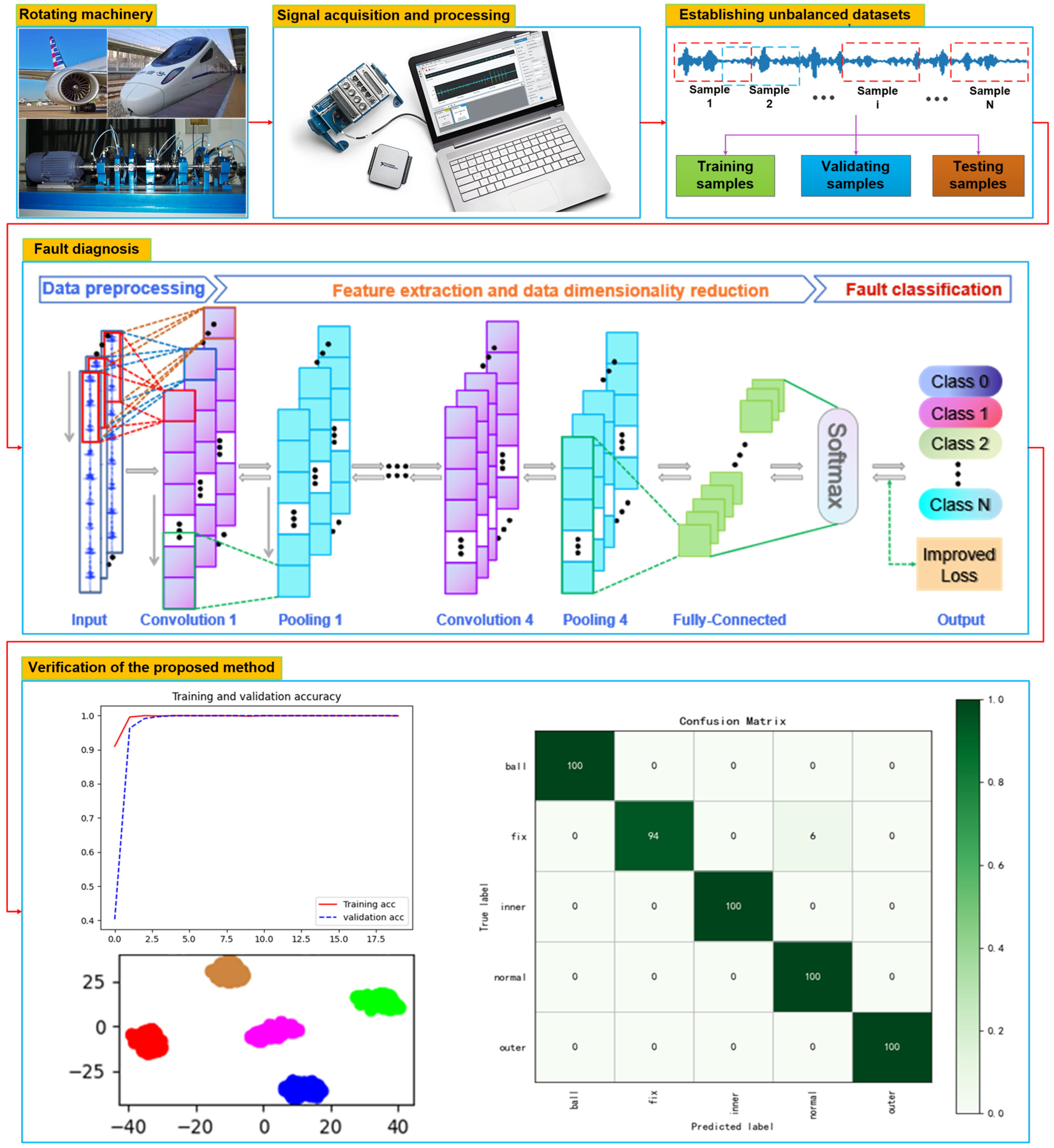

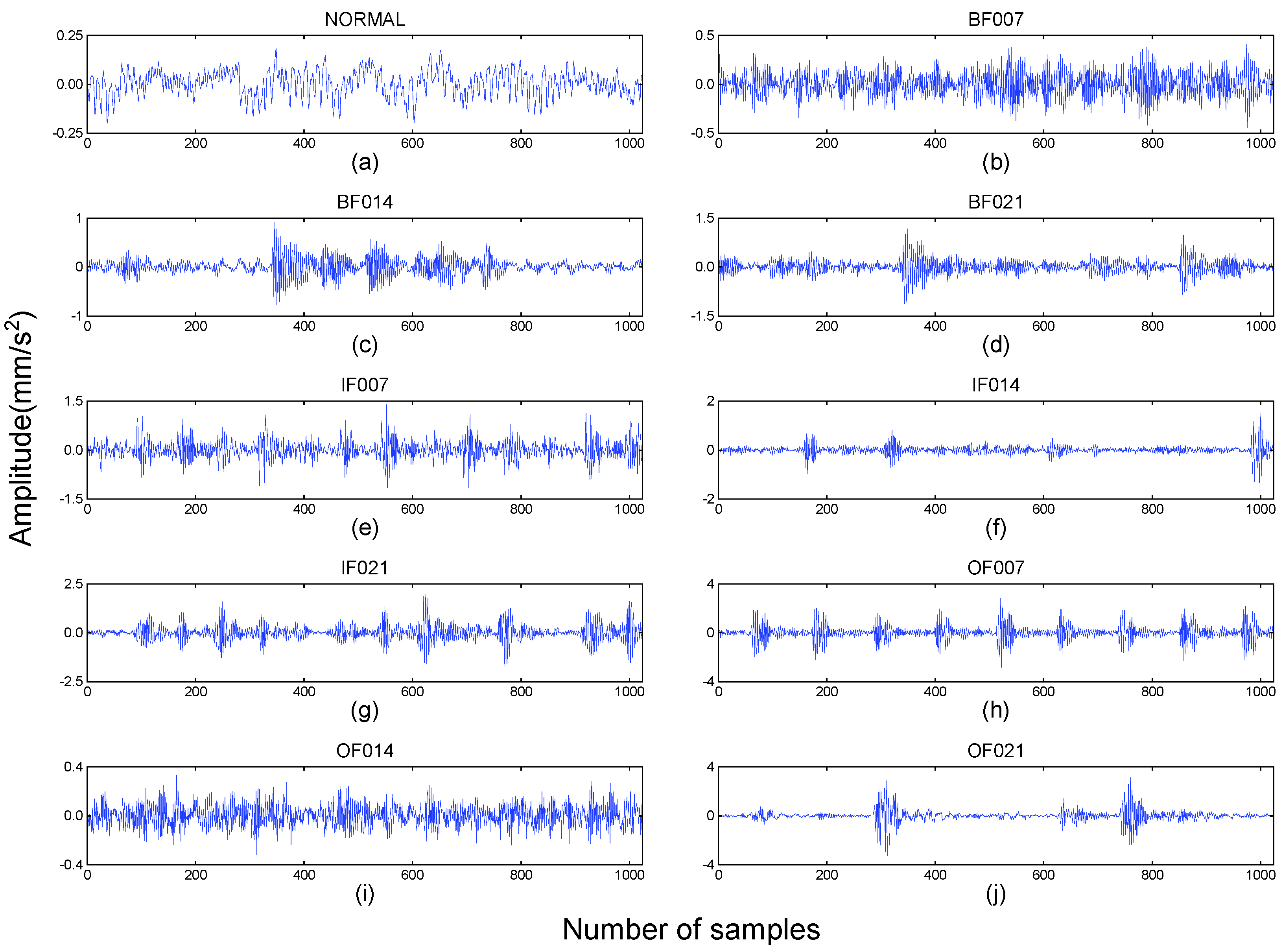
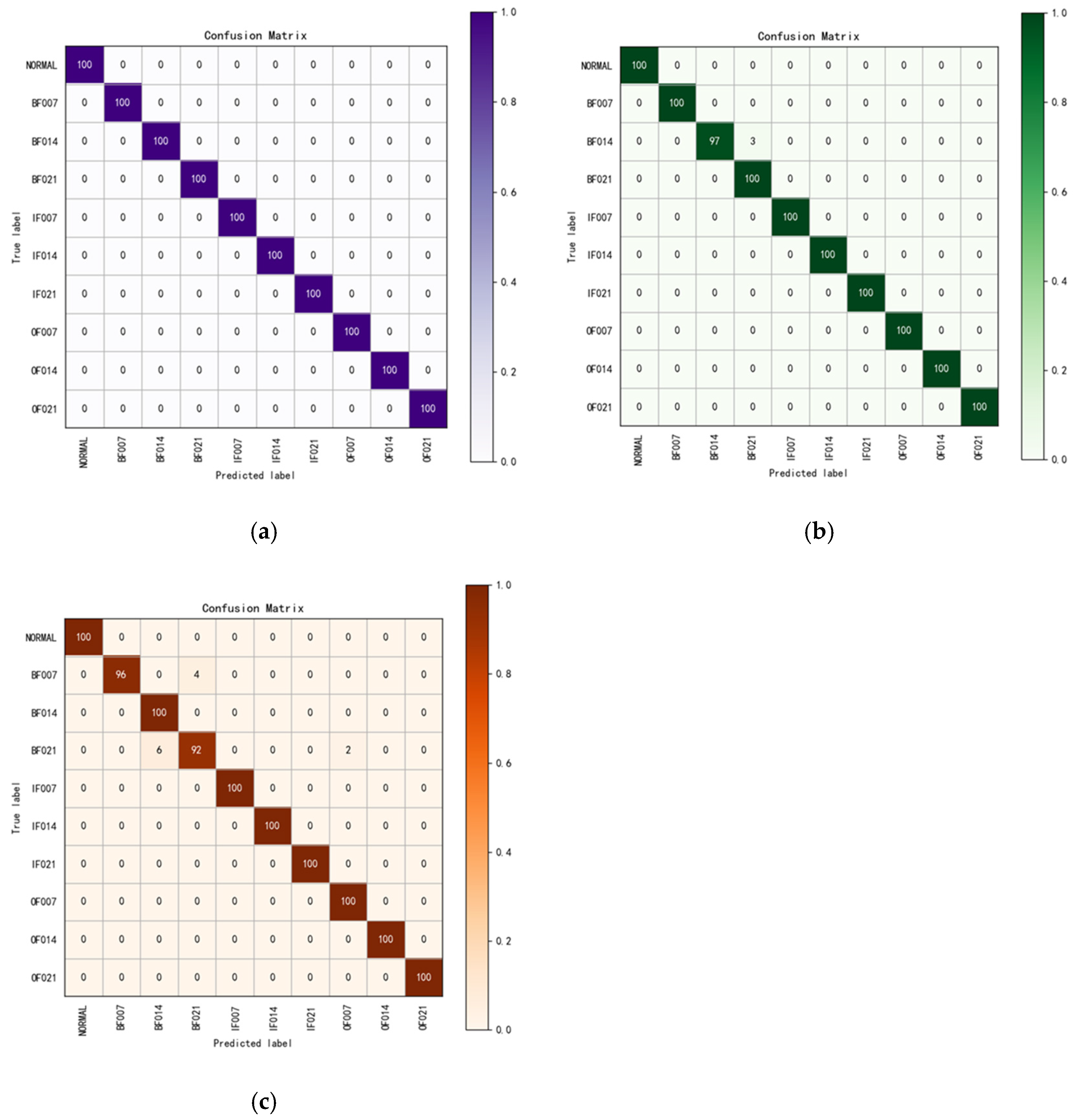
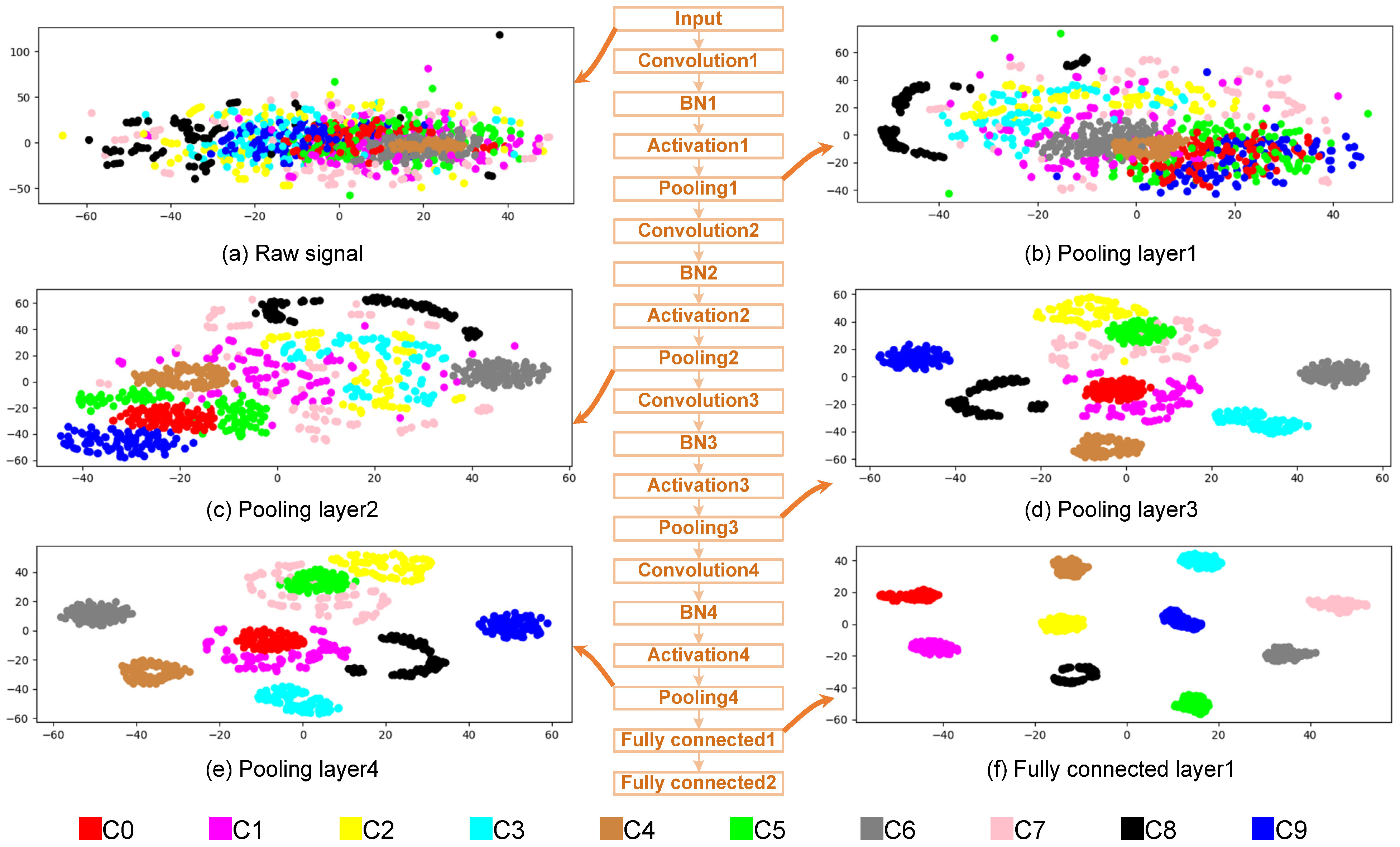
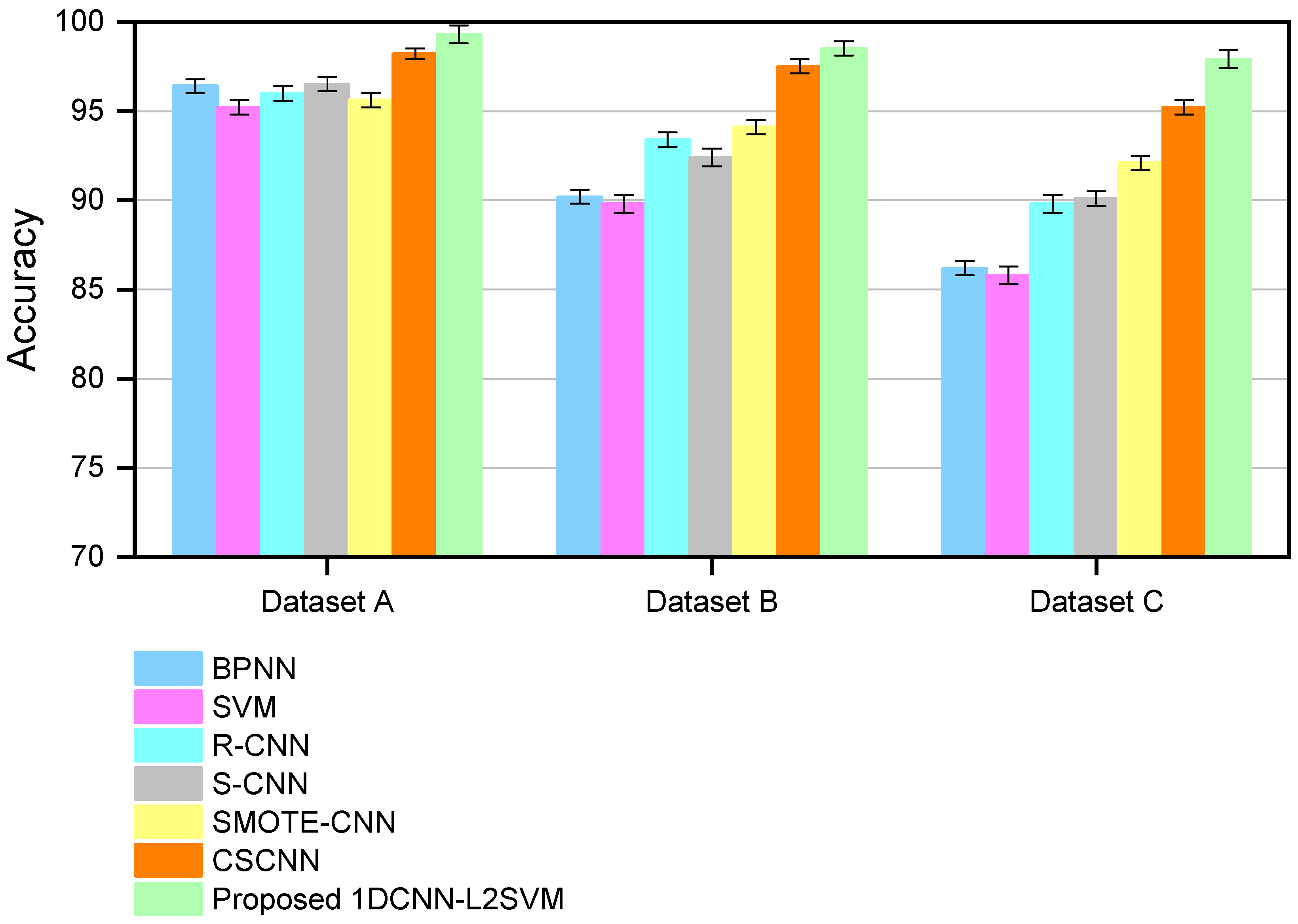

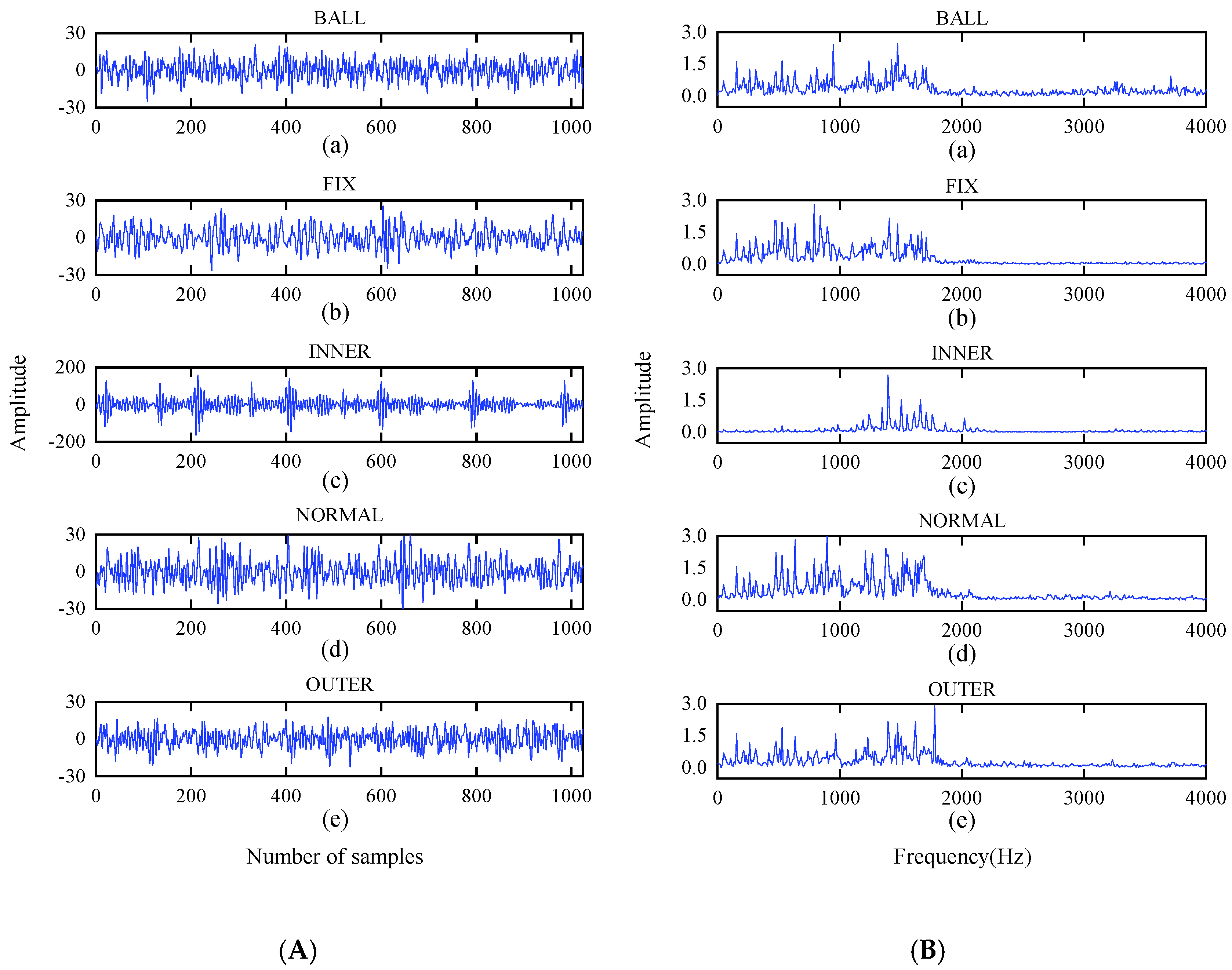
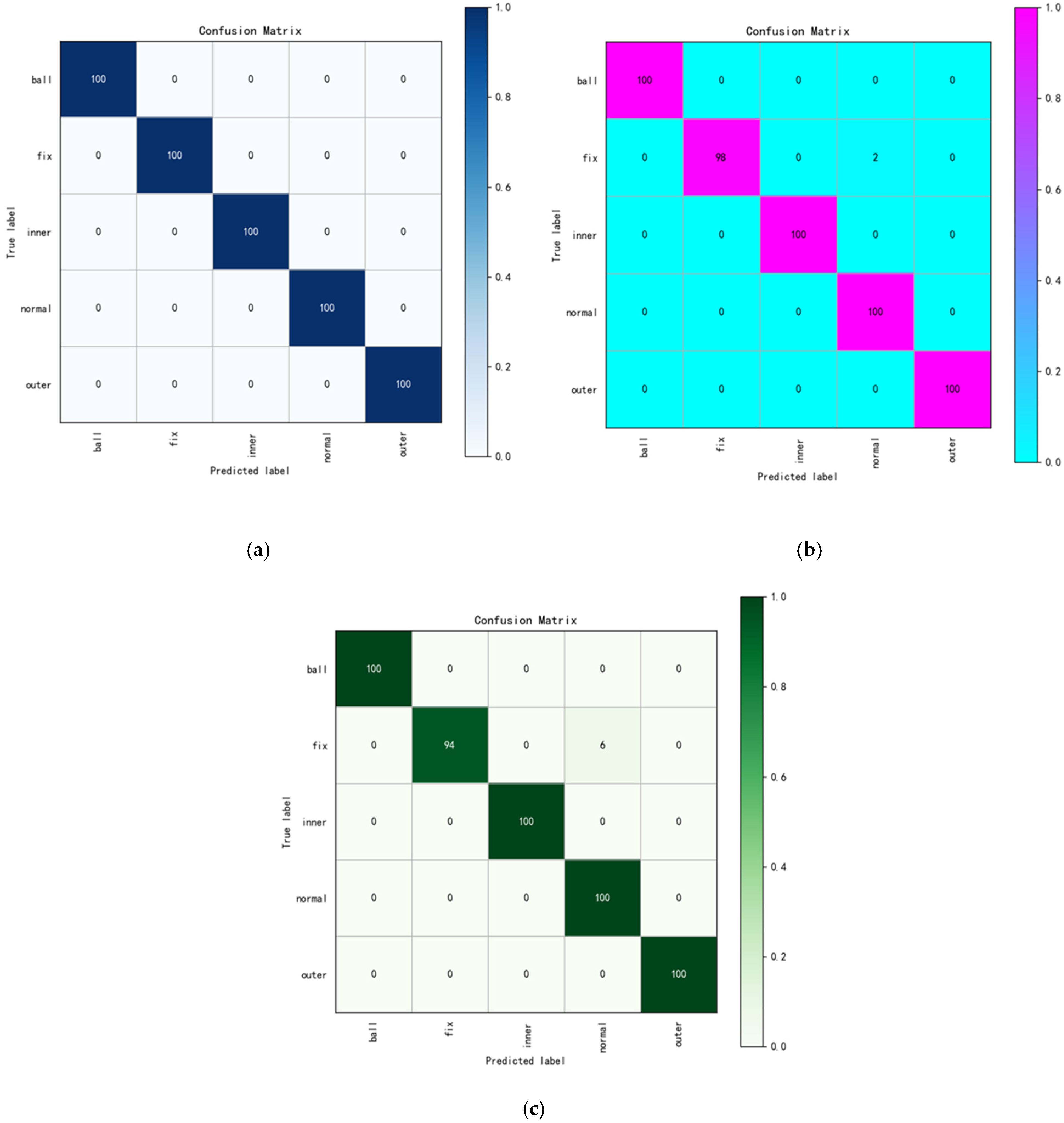
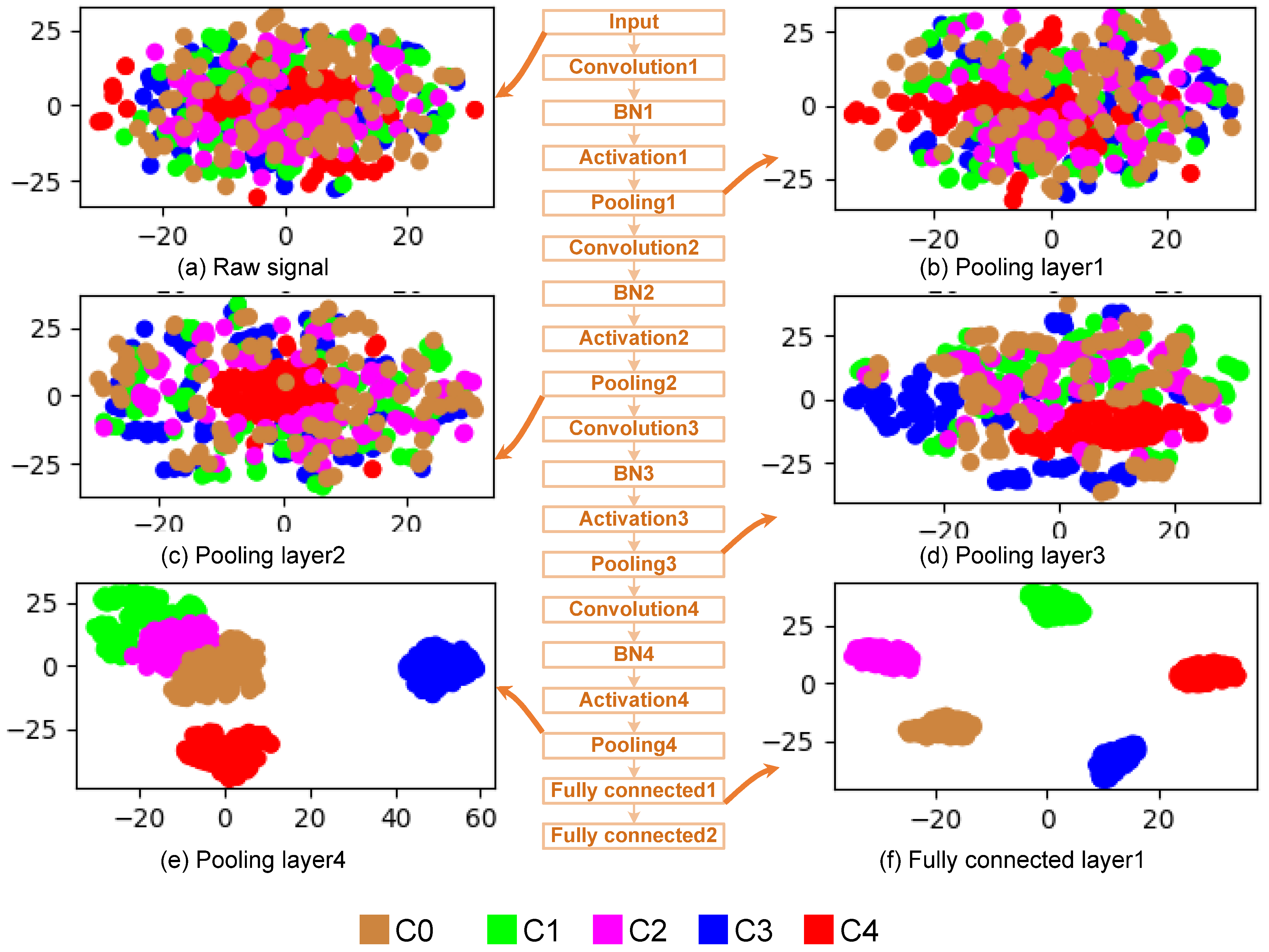
| NO. | Layer Type | Kernel Size/Stride | Kernel Number | Output Size (Width × Depth) | Padding |
|---|---|---|---|---|---|
| 1 | Conv(C1) | 16 × 1/1 × 1 | 16 | 1024 × 16 | √ |
| 2 | Pooling(P1) | 2 × 1/2 × 1 | 16 | 512 × 16 | × |
| 3 | Conv(C2) | 3 × 1/1 × 1 | 32 | 512 × 32 | √ |
| 4 | Pooling(P2) | 2 × 1/2 × 1 | 32 | 256 × 32 | × |
| 5 | Conv(C3) | 3 × 1/1 × 1 | 64 | 256 × 64 | √ |
| 6 | Pooling(P3) | 2 × 1/2 × 1 | 64 | 128 × 64 | × |
| 7 | Conv(C4) | 3 × 1/1 × 1 | 64 | 128 × 64 | √ |
| 8 | Pooling(P4) | 2 × 1/2 × 1 | 64 | 64 × 64 | × |
| 9 | Fully-connected1 | 100 | 1 | 100 × 1 | × |
| 10 | Fully-connected2 | 10 | 1 | 10 | × |
| Fault Location | None | Ball | Inner Race | Outer Race | |||||||
|---|---|---|---|---|---|---|---|---|---|---|---|
| Fault Diameter(mil) | 0 | 7 | 14 | 21 | 7 | 14 | 21 | 7 | 14 | 21 | |
| Class label | 0 | 1 | 2 | 3 | 4 | 5 | 6 | 7 | 8 | 9 | |
| Dataset A (0 hp) | Training | 700 | 700 | 700 | 700 | 700 | 700 | 700 | 700 | 700 | 700 |
| validation | 200 | 200 | 200 | 200 | 200 | 200 | 200 | 200 | 200 | 200 | |
| Testing | 100 | 100 | 100 | 100 | 100 | 100 | 100 | 100 | 100 | 100 | |
| Dataset B (1 hp) | Training | 2000 | 120 | 160 | 100 | 200 | 240 | 160 | 200 | 250 | 325 |
| validation | 900 | 80 | 40 | 100 | 100 | 60 | 140 | 200 | 150 | 75 | |
| Testing | 100 | 100 | 100 | 100 | 100 | 100 | 100 | 100 | 100 | 100 | |
| Dataset C (2 hp) | Training | 6900 | 80 | 60 | 70 | 200 | 150 | 100 | 150 | 100 | 200 |
| validation | 3000 | 20 | 40 | 30 | 50 | 100 | 200 | 150 | 200 | 100 | |
| Testing | 100 | 100 | 100 | 100 | 100 | 100 | 100 | 100 | 100 | 100 | |
| Absolute mean | Crest factor | ||
| Variance | Root mean square | ||
| Crest | Pulse factor | ||
| Clearance factor | Skewness | ||
| Kurtosis | Shape factor |
| Average frequency | Mean energy | ||
| Crest | Variance | ||
| Kurtosis |
| Fault Location | Ball | FIX | Inner Race | NONE | Outer Race | |
|---|---|---|---|---|---|---|
| Class label | 0 | 1 | 2 | 3 | 4 | |
| Dataset A (2600 r/m) | Training | 1000 | 1000 | 1000 | 1000 | 1000 |
| validation | 900 | 900 | 900 | 900 | 900 | |
| Testing | 100 | 100 | 100 | 100 | 100 | |
| Dataset B (2800 r/m) | Training | 70 | 80 | 200 | 1000 | 200 |
| validation | 30 | 20 | 100 | 900 | 200 | |
| Testing | 100 | 100 | 100 | 100 | 100 | |
| Dataset C (3000 r/m) | Training | 60 | 30 | 100 | 7000 | 150 |
| validation | 40 | 70 | 200 | 900 | 250 | |
| Testing | 100 | 100 | 100 | 100 | 100 | |
Publisher’s Note: MDPI stays neutral with regard to jurisdictional claims in published maps and institutional affiliations. |
© 2022 by the authors. Licensee MDPI, Basel, Switzerland. This article is an open access article distributed under the terms and conditions of the Creative Commons Attribution (CC BY) license (https://creativecommons.org/licenses/by/4.0/).
Share and Cite
Hu, B.; Liu, J.; Zhao, R.; Xu, Y.; Huo, T. A New Fault Diagnosis Method for Unbalanced Data Based on 1DCNN and L2-SVM. Appl. Sci. 2022, 12, 9880. https://doi.org/10.3390/app12199880
Hu B, Liu J, Zhao R, Xu Y, Huo T. A New Fault Diagnosis Method for Unbalanced Data Based on 1DCNN and L2-SVM. Applied Sciences. 2022; 12(19):9880. https://doi.org/10.3390/app12199880
Chicago/Turabian StyleHu, Baoquan, Jun Liu, Rongzhen Zhao, Yue Xu, and Tianlong Huo. 2022. "A New Fault Diagnosis Method for Unbalanced Data Based on 1DCNN and L2-SVM" Applied Sciences 12, no. 19: 9880. https://doi.org/10.3390/app12199880
APA StyleHu, B., Liu, J., Zhao, R., Xu, Y., & Huo, T. (2022). A New Fault Diagnosis Method for Unbalanced Data Based on 1DCNN and L2-SVM. Applied Sciences, 12(19), 9880. https://doi.org/10.3390/app12199880





